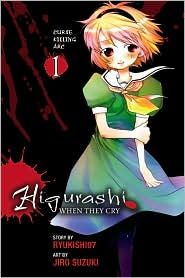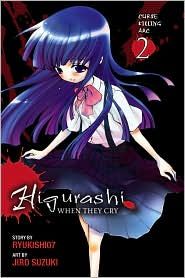The third rendition of this horror tale -- known as the "Curse Killing Arc" -- takes an unexpected left turn, departing from the supernatural emphasis of the first two arcs in order to explore the very human face of evil. This move is more than just effective storytelling -- it also offers an entirely new experience of a story the reader only thinks they already know.
Once again, it is important to know that each arc of Higurashi: When They Cry is a variation on a theme using the same basic characters and settings. In each arc, a teenage boy named Keiichi moves to a small town which has long suffered under a supernatural curse that ensures at least one person dies each year during a special cultural festival. Also, each arc generally ends up with the same result, which usually happens to be lots of people dying, disappearing, or going crazy. Sometimes they do all three. In varying order. It is only the differing paths and arrangements of characters and relationships by which the end result is reached that distinguishes each arc from the others. The remarkable thing about this particular horror story is how it lulls you into a sense of complacency after you've read a few arcs. You think you know the rules the game, but with the third arc a number of rules from the first two are violated so thoroughly that I found myself rediscovering not only some of the original horror of the story, but new and unexpected horrors as well.
While the first two arcs seem to purposefully twist the shonen harem genre in delightfully warped ways, the third instead offers a tender portrait of genuine friendship. Keiichi is no longer a mere "average boy" construct to be fawned over by a bunch of girls, who seem to exist only to make him lunch and may or may not turn out to be murderously evil. Instead, as a recent transfer student to a very small town, he and new his neighbors are busy getting to know each other in realistically high-spirited ways for their age. The most important of these friends -- Satoko -- is an elementary school student who delights in embarrassing the older Keiichi by pulling a series rather inspired pranks on him. Importantly, Satoko and Keichi develop a strong and emotionally rich bond as Satoko sees her missing older brother in everything Keichi does. In response to the clear absence in her heart, Keiichi is so moved he strives to become her replacement family. While the other girls aren't given as much depth as Satoko in these volumes, Keiichi's circle of friends is still remarkable in that it actually includes other boys. In other words, this arc replaces the harem with something completely different and in doing so creates a fertile ground for new ways to completely upend everyone's existence.
In previous arcs, when saw yourself from the main character's point-of-view, you were usually encouraged to wonder, "What if the cute girl next door wanted to kill me?" Here a much darker and more disturbing question forms -- what kind of evil could possibly destroy such happy days and youthful and innocent friendships? It is only because the bonds portrayed seem so genuine that it becomes necessary for the writer to create a force as equally powerful in order to break those bonds down. What ends up intruding upon these happy days is the real world terror of domestic abuse in volume 6. Keiichi is faced with the hellish reality that as a child he can't save his good friend, Satoko, from suffering at the hands of her horrible relative. Driven to despair at his own powerless, Keiichi's attempts to "save" her only implicates him in the violence and terror Satoko wants to escape.
While child abuse is a surprisingly melodramatic turn for this narrative exercise in horror, it works particularly well here because of the emotional foundation laid so carefully in volume 5. For the most part, the conclusion to the story succeeds thanks to its psychological portrait of children who are tragically cornered -- almost mentally tortured -- by basic human injustice. The story, as always, relentlessly moves toward the terrible destruction of the characters, but in this case the cascading acts of violence -- culminating in one truly shocking event -- seem almost self-inflicted. These two volumes have a much darker tone than the two previous arcs, as the psychology of violence replaces the strange logic of the supernatural, making this version all that much more compelling in its fresh take on the expected formula.
Review copies provided by Yen Press.



